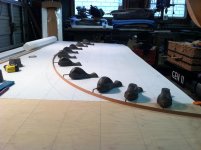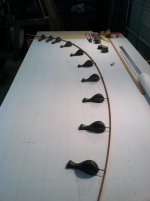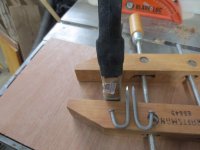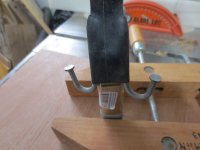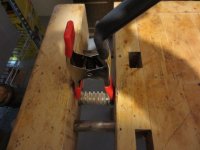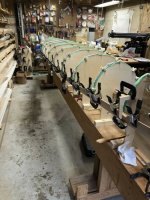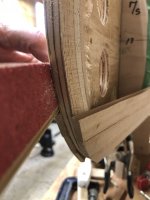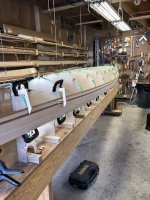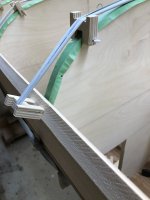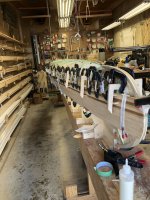Just a couple of items, then we delve into getting the forms setup, so I can actually start stripping.
First strip clamping ... I made up 36 of these clamps that Jim Dodd came up with. They have no name currently that I am aware of, so I have gone ahead and named them "Jimmy Clamps", not official, but it is the name I am going to use for these posts .... my hope is that the name sticks.
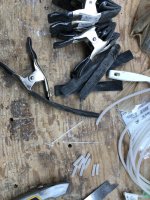
Second are the items I use to do the stem beveling. I also got the idea of a sanding stick from the Michne site. I currently use a couple of flavours.
For this build I made up a new one, this one is 2 wide, with 60 grit one side, 36 grit other side, I use this to do the rough bevel, the 36 grit really does a fast job of doing the majority of wood removal.
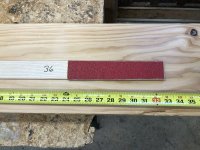
I do the final bevel with this one, which is 2 strips and 60 grit on both sides ... with a small space at the cove side. That space is important if you make one of these. If the sandpaper is lower, you start sanding the strip it is sitting on, not good.
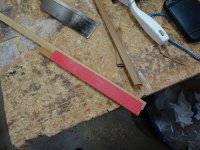
And from a previous build, a shot of how it fits
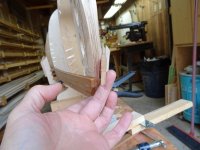
Now on to form setup. The form setup supports, start at the strongback center and follow the same regime as described in the post on lofting the shape of the donor boat. The forms are spaced at 12", the loft molds where at 11", this change lengthens the boat to just over 15' (the target length).
Setting the bow mold assembly
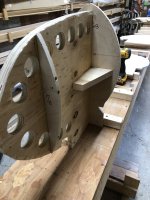
I am showing 2 sides, to demonstrate that this form needs a couple of braces to keep it aligned and solid, there is a small footprint that contacts the strongback
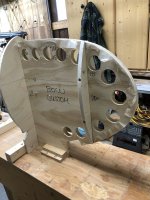
Once the bow and stern have been installed, a string is rigged between the center point of each, it is elevated enough that it will clear the highest mold.
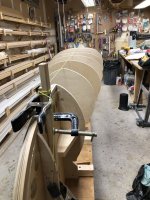
Each mold has several lines and reference marks on them, there is a center line mark down one face, this is continued at the top.
Start adding forms from one end, aligning the center of the mold with the center line on the strong back, the top mark gets aligned with the string.
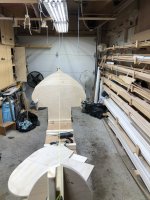
To make alignment more finicky, I also add a couple of brackets and make sure it is level side to side.
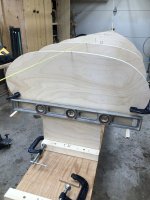
And they are all installed

One step that I don't have a pic of is each form needs to be vertical, this is usually done by adding a strip running near the top, bow to stern. Nail it to each, then level each form and nail it in place. I did do this, but a strip at the top would interfere with the tie down system I am trying, so there is a support in between the forms holding them level.
Once all forms are installed, use your eye, fairing strips, whatever you have. Look at the forms to see if they look, is the rate of change between forms, front to back "look" right. I am a firm believer that our sight is very good at picking out anomalies. If it looks good, try laying a strip along the top, along the bilge, along the sheer, do they all look to follow some symmetry.
Doing this I found one form where I had done revision didn't look "right" and needed some adjustment.
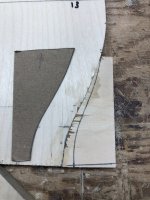
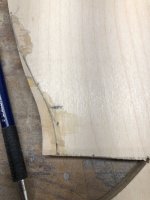
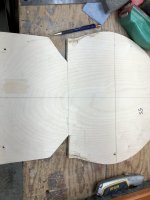
One form out a bit is a win in my book, given all the changes and mods done.
The tie down I am trying are basically rubber tie downs centered on each form. The idea is that it can swing to either side and should be fairly fast and easy to use.
The connecting "thingy" is just bent clothes hanger wire, the center pivot is a 2" #8 cap screw
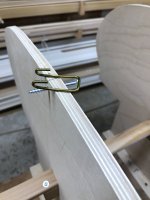
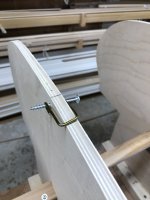
I ordered some Theraband Silver and cut it up into 2" strips for the tie down, and some 3/8" strips to do the wrap/loc used to make a loop at one end around the "thingy" and a larger loop at the other end to go around the form edge ( I have a strip rest there)
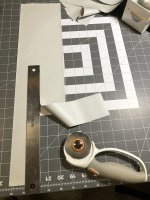
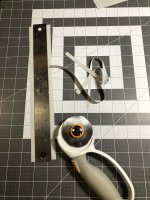
Rather than do a tutorial on how to wrap and attach, if you Google "attaching slingshot rubber band" you will get the idea very quickly.
Getting the first strips on and aligned took quite a bit of time, but here it is ... aligned and first strips on ....
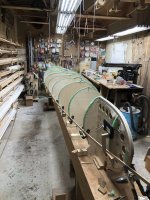
Now the fun can begin.
Brian

